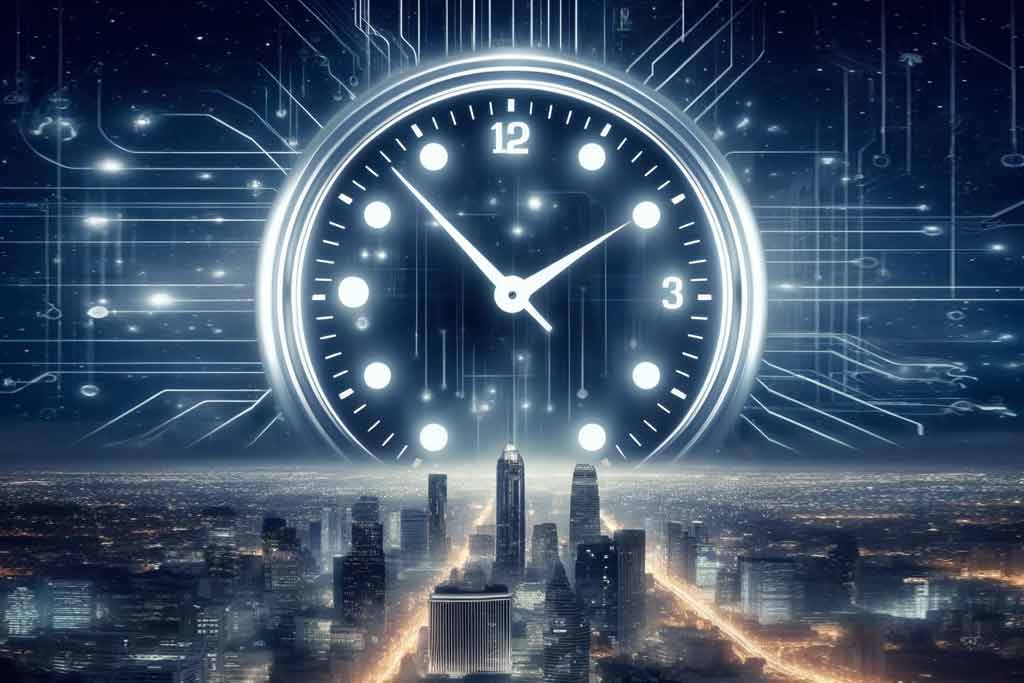Y2K is back! If you’ve scrolled through TikTok recently, you’ve probably noticed a surge in Y2K-themed content. From thrift stores to fashion to tech nostalgia, Gen Z and millennials are bringing back the millennium bug era with a pop culture twist. But what about the origins of this nasty little computer bug? Gen Z’ers, you might be scratching your head right now, wondering what all the fuss was about. Picture this: it’s the late 1990s, grunge is on its way out, boy bands and Britney are in. Everyone is wondering what Paris Hilton is going to do next, and only the rich kids had cell phones. Dial-up modems are making that weird screechy noise as they connect to AOL, and you’re hoping nobody picks up the landline and ruins the connection. Life is good.
But lurking in the background, amidst all the boy bands and beepers, is something sinister—something techy and scary that has everyone from computer geeks to government officials in a tizzy. It’s called the Y2K bug, and it’s threatening to turn your digital life upside down as the clock strikes midnight on December 31, 1999.
You’ve heard the rumors: planes falling from the sky, bank accounts resetting to zero, your Tamagotchi suddenly coming back to life and demanding food (okay, maybe not that last one). As you stock up on bottled water and canned beans (because hey, who knows what’s going to happen), you can’t help but wonder: what is this Y2K bug, and why is it causing so much panic?
Sit tight, and let’s rewind to the last year of the millennium—a time when our biggest fears were not just what would happen when Ross found out about Chandler and Monica but what would happen to our computer chips when they had to deal with the big, bad “00.” Buckle up, folks, we’re diving into the Y2K phenomenon!
Discovery and Origins
Let’s go back to the early days of electronic computers, the 60s and 70s when computer programmers were rocking bell-bottoms and typing away on massive mainframe computers…groovy. These clever folks decided to save precious memory space by using two-digit codes to represent the year. For example, instead of 1970, they’d just write ‘70’. Fast forward to the 90s, and suddenly, the future looked a bit scary. What would happen when the year turned to 2000? Would ‘00’ be read as 2000 or 1900? Spoiler alert: widespread chaos could ensue!
The Y2K problem, as it became known, was first flagged in the United States by engineers like Bob Bemer, an IBM guru who, along with David Eddy, began to raise alarms. But much like your dad ignoring the check engine light on the car, the issue didn’t get the attention it deserved until we were racing towards the new millennium.
From Finance to Ferris Wheels
So, what systems were potentially on the fritz? Pretty much anything with a computer chip or date-sensitive software. Here’s a quick rundown:
Banking and Financial Services: Imagine your bank account getting wiped out because the computer thinks it’s 1900 again. Interest rates, loan payments, credit card accounts, stock trades—everything was at risk.
- Utilities Systems: Electricity, water supply, and other essential services could have gone kaput. No lights, no water—basically, an apocalyptic scenario.
- Transportation Systems: Planes falling from the sky, trains stopping in their tracks. Okay, maybe not that dramatic, but air traffic control and railway systems were in serious danger.
- Healthcare: Your medical records might’ve said you were born in 1900, which could lead to a lot of confusion at the doctor’s office.
- Government Organizations and Defense: National security systems, missile launches (yikes!), and government databases—all potentially vulnerable.
- Temperature-Control Systems: HVAC, refrigeration units, medical equipment, and agricultural systems were all at risk of hardware failures.
The Great Panic and Preparation
As 1999 was winding down, fear was winding up. Governments, businesses, and everyday people were bracing for the worst. Media outlets were having a field day, painting pictures of dystopian futures. Cue the doomsday prepping!
Public Perception: If you were around back then, you probably remember the media frenzy. People were hoarding canned food and bottled water like it was the end of days. The question on everyone’s lips: Would civilization survive the stroke of midnight?
Notable Figures: Tech moguls like Bill Gates were urging caution, while President Bill Clinton set up the President’s Council on Year 2000 Conversion, led by John Koskinen. This task force was like the Avengers for computer bugs.
Corporate and Government Efforts: Companies like IBM, Microsoft, and Oracle spent billions of dollars and countless hours fixing code, replacing hardware, and testing systems. The U.S. government passed the Y2K Readiness Disclosure Act to encourage transparency and readiness among businesses and public institutions.
The United Nations and Global Coordination
Even the United Nations got in on the act, urging countries worldwide to address Y2K issues. Conferences were held, strategies were shared, and a global sense of “we’re in this together” prevailed. It was like a giant, worldwide group project—only with much higher stakes than a high school science fair. How did we avert disaster? Here’s the play-by-play:
- Code Review and Remediation Projects: Organizations scoured their software for date-related bugs. Programmers worked like mad, updating computer programs and code to use four-digit years.
- Testing: They tested and retested systems to make sure everything would work smoothly come January 1, 2000.
- Contingency Planning: Backup systems were readied, manual procedures were dusted off, and emergency plans were put in place.
- Public Communication: Governments and companies kept the public informed, calming nerves and ensuring everyone knew what was being done.
The Clock Strikes Midnight
And then, it happened. Midnight. The ball dropped, fireworks exploded, and… nothing. Well, almost nothing. A few minor glitches here and there, but overall, it was a smooth transition. The world didn’t end, the power stayed on, and the stock market didn’t crash. The Y2K problem turned out to be the biggest non-event in modern history, thanks to the tireless efforts of programmers and IT professionals worldwide.
Back in the Spotlight
Y2K is making a comeback in popular culture, but not in the way you might think. So, why is Y2K suddenly cool again? Let’s dive into the reasons behind this retro resurgence.
The Nostalgia Factor: First and foremost, nostalgia plays a huge role. The late 90s and early 2000s were a simpler time, at least in memory. For many, Y2K represents a period of excitement and anticipation for the future. The fashion trends, the music, the tech—it all has a certain charm that today’s younger generation finds intriguing. From baggy jeans and chunky sneakers to velour tracksuits, the fashion world is once again brimming with the bold colors of the 1990s, reinventing them into a new look for this generation.
Y2K Fashion: Y2K fashion is all about those bold, eclectic looks. Think low-rise jeans, butterfly clips, shiny fabrics, and tiny sunglasses. TikTok influencers are embracing these styles, often with a modern twist. The hashtag #Y2Kfashion has millions of views, with creators showcasing their thrifted finds and DIY projects. It’s a fun way to recycle trends and make them relevant again.
Tech Curiosity: Remember when the coolest gadget was a Nokia 3310 or a PalmPilot? For today’s youth, who’ve grown up in a world of smartphones and social media, looking back at the tech of the Y2K era is both amusing and fascinating. Videos featuring retro tech gadgets and early internet experiences are gaining popularity on TikTok. It’s a trip down memory lane for some and a history lesson for others.
The Humor of Y2K Panic: Let’s face it, the Y2K panic is kind of funny in hindsight. The idea that the world’s computers might go haywire because they couldn’t handle the year 2000 is both ridiculous and charming. TikTok creators are capitalizing on this humor, making videos that parody the fear and preparations people went through. It’s a blend of educational content and comedy that resonates well on the platform.
Viral Challenges and Trends: TikTok is known for its viral challenges, and Y2K-themed ones are no exception. Users are participating in challenges like “Y2K Outfit Challenge” or “90s Tech Unboxing,” sharing their best throwback looks and experiences. These trends create a sense of community and shared nostalgia, encouraging more people to join in and keep the Y2K conversation alive.
Y2K’s resurgence on TikTok is a blend of nostalgia, humor, and cultural exploration. It’s a reminder of a time when the future was uncertain, yet full of possibilities. For those who lived through it, it’s a chance to reminisce and laugh. For those who didn’t, it’s an opportunity to discover and appreciate a unique slice of history. So, whether you’re dusting off your old butterfly clips or marveling at a vintage flip phone, enjoy the Y2K revival. It’s a blast from the past that’s here to stay—at least until the next viral trend takes over.
The Disaster that Never Happened
The Y2K phenomenon is a fascinating chapter in the history of technology and human ingenuity. It’s a reminder of how far we’ve come and how much we rely on the unseen world of computer code. For those who lived through it, it was a time of uncertainty and frantic preparation. For those who didn’t, it’s a curious tale of a world on the brink of the digital age, facing its first major test. And in the end, it was a test we passed with flying colors—thanks to the unsung heroes of the IT world who worked tirelessly behind the scenes.
So next time you hear someone mention Y2K, give a little nod to the programmers of yesteryear. They made sure we could ring in the new millennium with lights, water, and a fully operational internet. Cheers to that!


